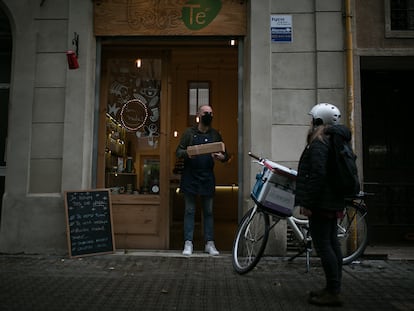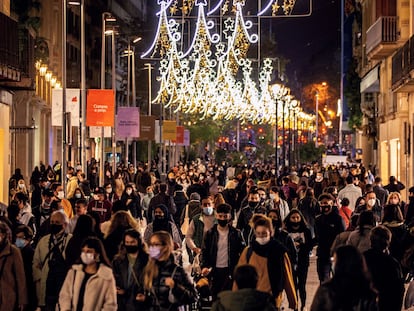Spain reports 8,257 new coronavirus cases and adds 442 deaths to official toll
In eight of the country’s 17 regions, the 14-day cumulative number of infections per 100,000 inhabitants has fallen below 250, a threshold that indicates “extreme risk”

The incidence rate of the coronavirus continues to fall across Spain, according to the latest Health Ministry report released on Tuesday evening. In eight of Spain’s 17 regions, the 14-day cumulative number of cases per 100,000 inhabitants has fallen below 250 – the threshold which the Health Ministry considers a situation of “extreme risk.” The eight regions are: the Balearic Islands, Canary Islands, Catalonia, Valencia, Galicia, Madrid, Murcia and Navarre. Only La Rioja (408), Castilla y León (403) and the North African exclave city of Melilla (402) have an incidence rate above 400 – last week 10 regions were above this figure and only two were below 250. The national 14-day cumulative number of cases per 100,000 inhabitants now stands at 265.76. If this figure continues to fall at the current rate – by more than 95 points each day – it will be below 250 on Wednesday.
The national incidence rate is likely to drop again, given the fall in new coronavirus cases. According to the Health Ministry’s report, 8,257 new infections were recorded on Tuesday, the lowest figure since October 13, when 7,118 cases were detected. This brings the total number of infections since the beginning of the pandemic to 1,656,444.
The seven-day cumulative number of victims stands at 1,823, the lowest figure recorded since November 3
This improvement was less clearly seen in the number of hospitalizations, intensive care unit (ICU) admissions and Covid-19-related deaths. Spain’s regions added 442 fatalities to the Health Ministry’s official count on Tuesday. This is more than the number reported on Monday (401), which included victims recorded over the weekend, and much higher than Friday’s figure of 294. But the seven-day cumulative number of victims – a figure which compensates for fluctuations due to weekends or delays in notifications – now stands at 1,823, the lowest number recorded since November 3 (1,197). This figure, however, was updated following a change in counting methods. Since November 11, the seven-day cumulative number of victims has been around 2,000 – an indication that the situation in Spain is far from showing a clear improvement. According to Tuesday’s report, the official death toll since the beginning of the pandemic now stands at 45,511.
The latest Health Ministry report also indicated that the pressure on Spain’s hospitals is easing. Covid-19 patients currently occupy 11.52% of all hospital beds, a rate that has been falling nonstop since November 9, when it stood at 17.28%. In ICUs, where patients are typically admitted for longer periods, the drop has been less dramatic, falling from 32.8% on November 16 to 26.3% on Tuesday. The average age of ICU patients has also been slowly rising during the second wave of the pandemic. Although the ICU occupation rate has fallen overall, in Aragón (41%), Asturias (38%), La Rioja (50%) and Castilla y León (40%), it remains above 35% – the threshold considered to indicate that ICUs are in danger of being overwhelmed.
Although coronavirus patients occupy 40% of ICU beds in Castilla y León, the region announced on Monday that it will lift some of the restrictions aimed at curbing contagions. From Friday, the hostelry sector will be able to open sidewalk cafés and outdoor eating areas. In the provinces of León and Salamanca, all bars and restaurants will be allowed to reopen, albeit with restrictions on capacity, and sports centers and shopping centers will also be able to open to the public. This is already allowed in Segovia and Ávila.
English version by Melissa Kitson.
Tu suscripción se está usando en otro dispositivo
¿Quieres añadir otro usuario a tu suscripción?
Si continúas leyendo en este dispositivo, no se podrá leer en el otro.
FlechaTu suscripción se está usando en otro dispositivo y solo puedes acceder a EL PAÍS desde un dispositivo a la vez.
Si quieres compartir tu cuenta, cambia tu suscripción a la modalidad Premium, así podrás añadir otro usuario. Cada uno accederá con su propia cuenta de email, lo que os permitirá personalizar vuestra experiencia en EL PAÍS.
¿Tienes una suscripción de empresa? Accede aquí para contratar más cuentas.
En el caso de no saber quién está usando tu cuenta, te recomendamos cambiar tu contraseña aquí.
Si decides continuar compartiendo tu cuenta, este mensaje se mostrará en tu dispositivo y en el de la otra persona que está usando tu cuenta de forma indefinida, afectando a tu experiencia de lectura. Puedes consultar aquí los términos y condiciones de la suscripción digital.
More information
Últimas noticias
Rowan Atkinson tops Netflix at 70: ‘He’s as funny as ever’
Israeli recognition of Somaliland stirs up the Gulf
Tiger Woods turns 50: Will he continue playing on the PGA Tour or take a back seat?
The surreal journey of James Nnaji, the Barcelona youth player selected in the NBA Draft who ended up in the NCAA
Most viewed
- Oona Chaplin: ‘I told James Cameron that I was living in a treehouse and starting a permaculture project with a friend’
- Reinhard Genzel, Nobel laureate in physics: ‘One-minute videos will never give you the truth’
- Sinaloa Cartel war is taking its toll on Los Chapitos
- Why the price of coffee has skyrocketed: from Brazilian plantations to specialty coffee houses
- Chevy Chase, the beloved comedian who was a monster off camera: ‘Not everyone hated him, just the people who’ve worked with him’










































